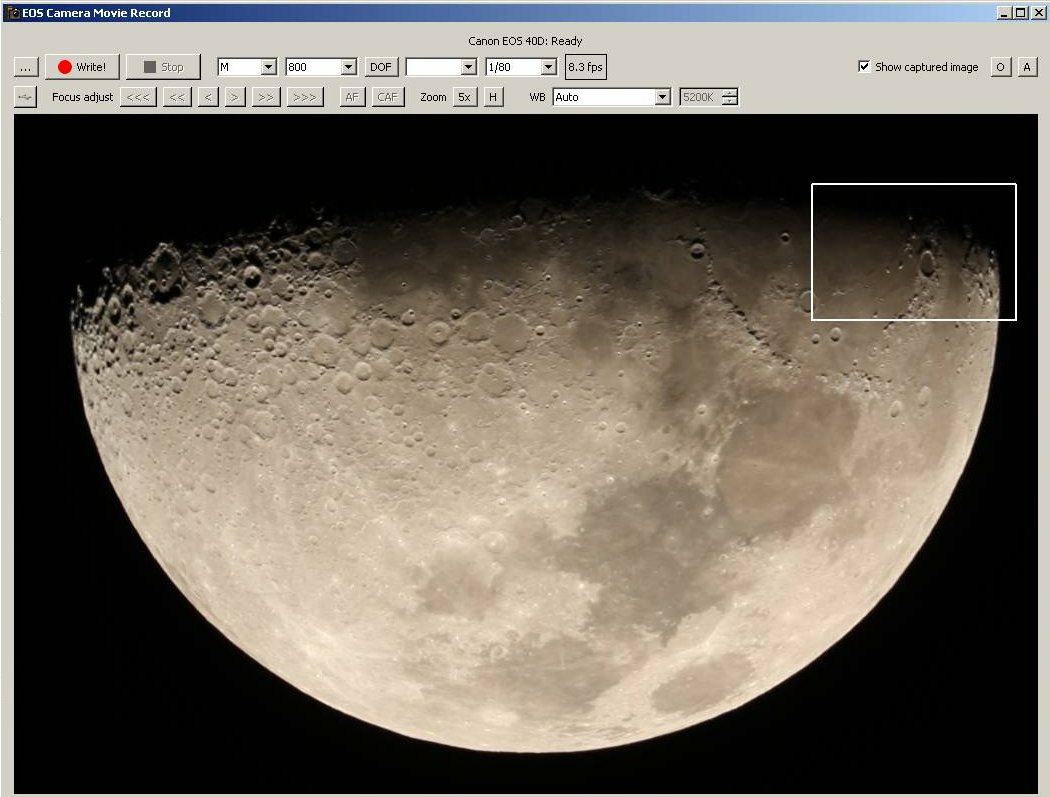
Using a Canon with liveview as a huge webcam
!
NEW ! The incredible liveview 5X ZOOM captures !!
(October 9, 2010)
Recent images with this technic !
Introduction :
I am very excited using such a large sensor as a webcam ! FOV is immense !
Here is a screen capture showing what is seen in livevew
with my LX200 12" :
It is the about half the field of full frame camera with a TSC 8" !

This will of course give nice complete Moon images ...
But what is even more remarquable is that if I want to
take a detailed shot,
I just have to move the white rectangle on it and then use the 5X zoom without
touching to the telescope !
Moreover, our Screen Vision
software will help me to get a very precise focus !
The field then is the one of a good planetary camera ... see this
picture taken on the left side
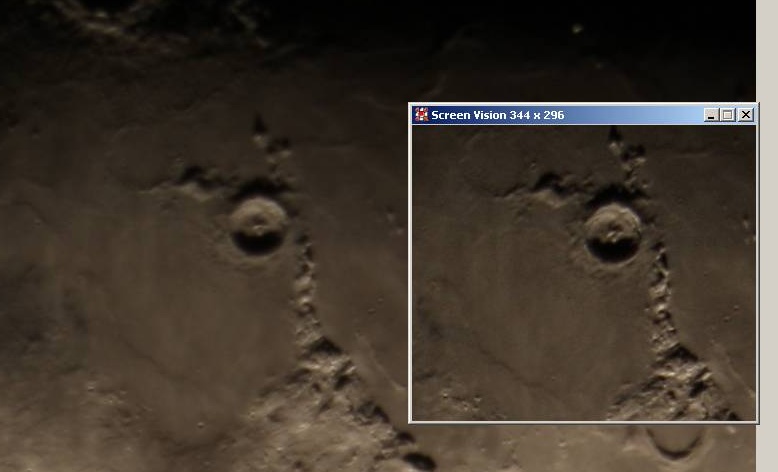
In my case it is my Canon 40D*
but it could be another one 1000D, 450D, 500D, 50D, 7D***
... you just need Liveview !
Of course the best for size, speed, would be with a 5D MarkII ! You are a lucky
guy if you have one !
*** Thanks to Bruce from
Toronto who tested 0.2.2 beta at 30fps (still, autofocus may have some problems
...)
Step by step ... How to do your captures :
Note : I did not develop nor have actually any special
access to the development of this software !!
If you would like improvements, contact the main developer at sourceforge...
Download latest version of EOS-movrec (the setup
file) at sourceforge
http://sourceforge.net/projects/eos-movrec/files/
(See for more infos if you like http://valexvir.narod.ru/)
Now just connect your EOS
- Attention set in manual mode and better without CF-card inside - into
your PC via the USB2 port,
wait until it is recognized
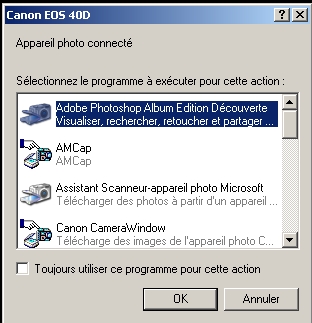
then close the Canon EOS window (yours will be of course in your usual language) :
Then open EOS-movrec software ... you will have such a window :)
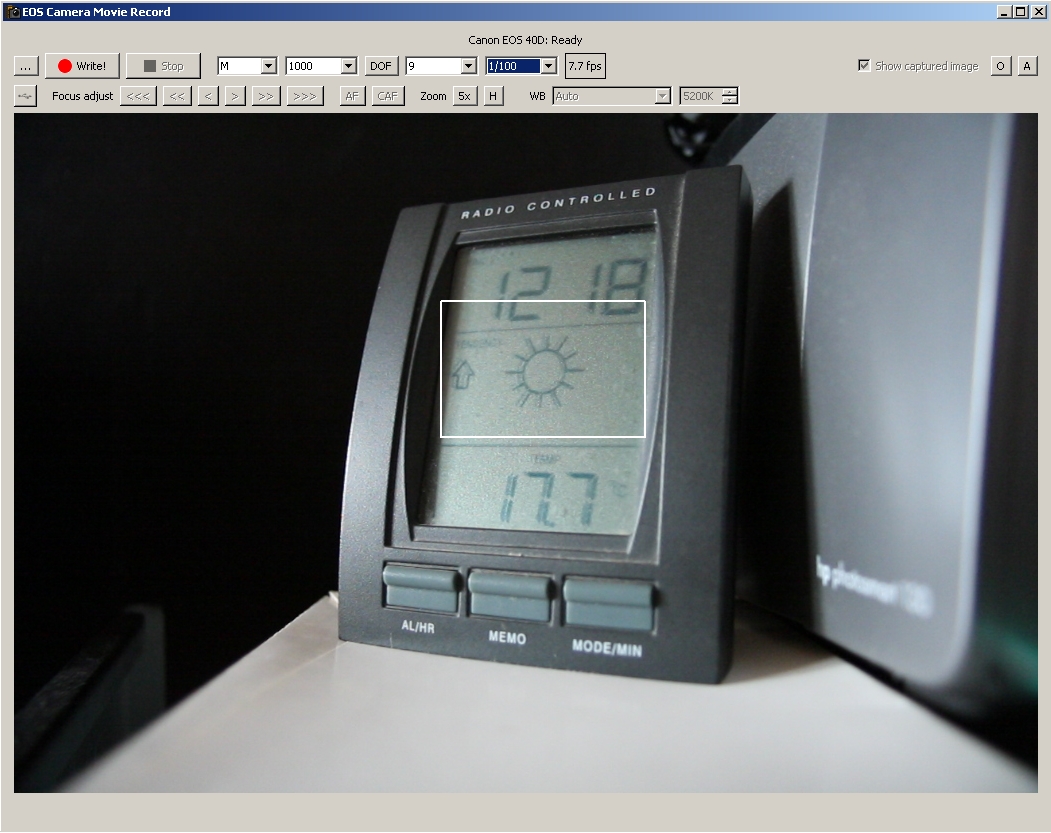
NOTES :
If you have a normal defiltered Canon EOS 40D (not Full IR defiltered
!), you may have to reset the WB to your custom WB : do it in the camera
menu followed by a hit on camera 'liveview' button...
In that case you may use this
image as a custom WB picture and this one if
you have a LPS filter in line !
I experiment with this software, more or
less disconnexion with the camera with a 6m long USB2 wire. Canon utilities
does never do that in the same conditions even connected for hours ! It is the
main problem I have. If it happens to you, you have to disconnect the USB2 cable,
eventually change from USB port, turn off the camera ...If
you put live video on the screen of the camera, then after a few min it will
turn off and kill the connexion at the same time.
Then be sure you don't face this kind of problem before attempting critical captures (eclipses or else) !
Then set :
1) Correct focus ... here you can use the 5x live zoom,
just move the white rectangle beforehand to an interesting place with the mouse
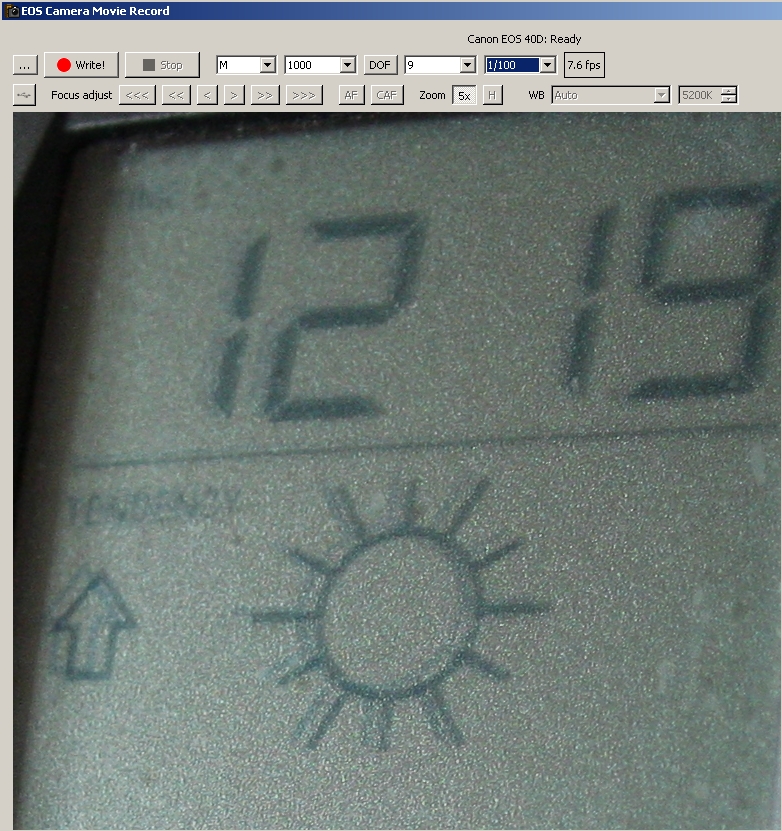
2) ISO, speed and finally control all this with DOF ...
3) Choose a folder and name for your AVI !
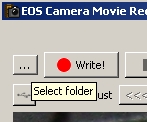
Note : if an AVI name already exists, the next one will have a generic incremented name.
You will generally see a capture speed of about 8 fps*
but ...
Now - With an older PC if you want fast capture - uncheck 'show
captured image'
Wao ! Capture speed jumps to more than 22fps (I have seen
almost 30fps sometimes) * !!!
click WRITE ... recording start ... you may stop it at any time.

NOTE : After 30 min the Canon 40D will reset
the liveview and EOSmovrec will freeze !
don't leave you PC unattended for more
than about 25min to be able to stop AVI recording, close and restart EOSmovrec
before this happens !
Otherwise the AVI will be broken and
VirtualDub needed to reconstruct the index ...
The incredible liveview 5X ZOOM captures !!
Note : 10x does not work but it is not important as with 5x we are already at the pixel level !
*** Most interesting :
If you click write while the 5X ZOOM is ON, you will record what is seen on
the screen with the 5X ZOOM and not the full frame !!
and what is absolutely incredible is that it is not an usual digital zoom ...
it is a software resize of the sensor (like the one on recent Panasonic cameras)
!
The resulting image is the image you would obtain with a CMOS with sizes 5X
smaller and with no resolution lost !
Here is the demonstration :
First lets see the FOV given with the Canon 40D +2X shortened barlow on the
PST (right click on image for full size) with EOS-movrec :
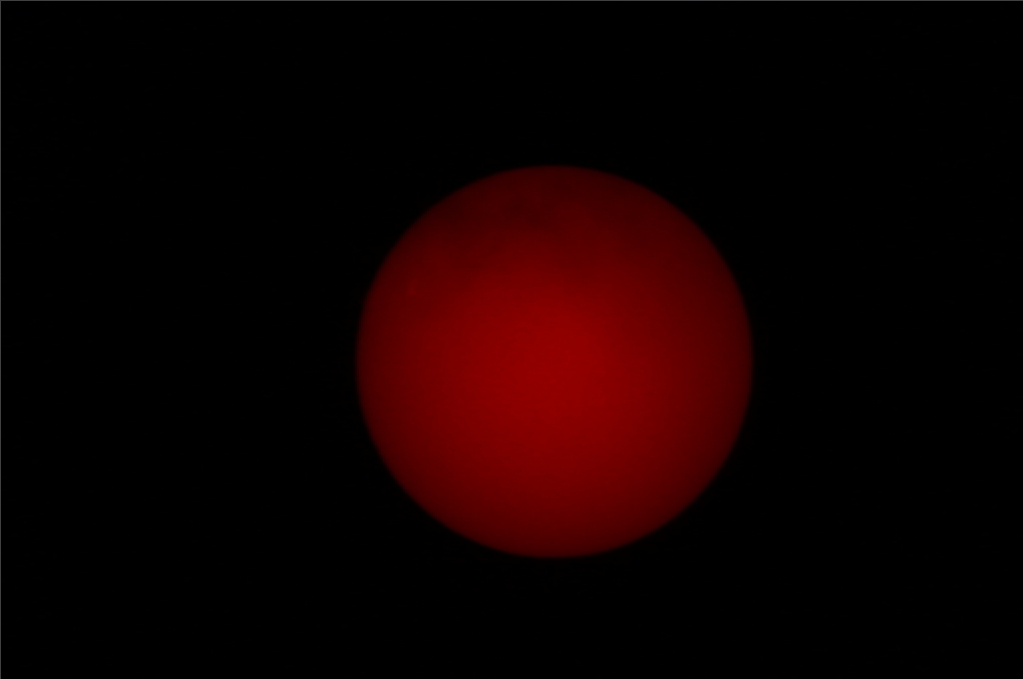
NOW the composite image below shows that the resolution, obtained with the Liveview+5XZoom
captures, is incredibly better
than the one obtained without zoom and latter magnified 5X by a good processing
software ! This is much better than a webcam and can compete with a DMK or a
Lumenera.
Remember that the Canon 40D and other Canon EOS have a dynamic of 14 bits at
the sensor digitalisation level !
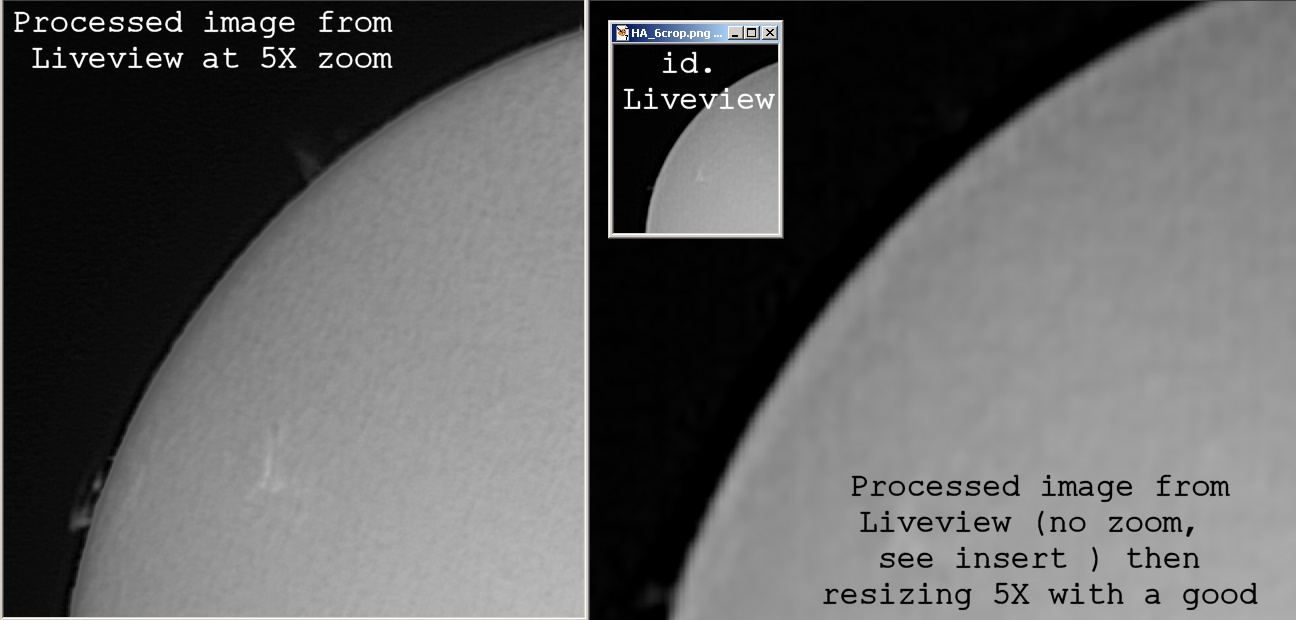
Here are the infos about the AVI written :

Moreover, you can place the region of interest
anywhere you want before going to liveview zoom !
Then you get the best of two worlds : a large FOV to easily
find what you want & then a high resolution on a selected part !
Such features are for me incredible news !
On the full field below (FOV of the
Canon 40D with 5x Zoom on PST+Barlow),
I shows in live XVID video the zone inside Screen Vision. click on image to see/download
it.
Features found Dec 17 :
When you are in the 5x zoom window, you can
directly move
at will the 5X zone with the mouse (when a hand !)
Still possible during recordings :
2 solutions :
1. You see on PC screen what you are doing when dragging with the mouse 7-10 fps
2. You enter liveview mode on the camera so you can record
at 30fps while still knowing what you do
for moves or tracking looking at its LCD. I like this ! You can also choose
to look at a video monitor connected with the video cable instead.
Beware that if not correctly set in the camera menus, if the camera exits liveview
mode after a few
min, connexion with EOS_movrec and recordings will stop !
Also you can change ISO setting and shutter speed ...
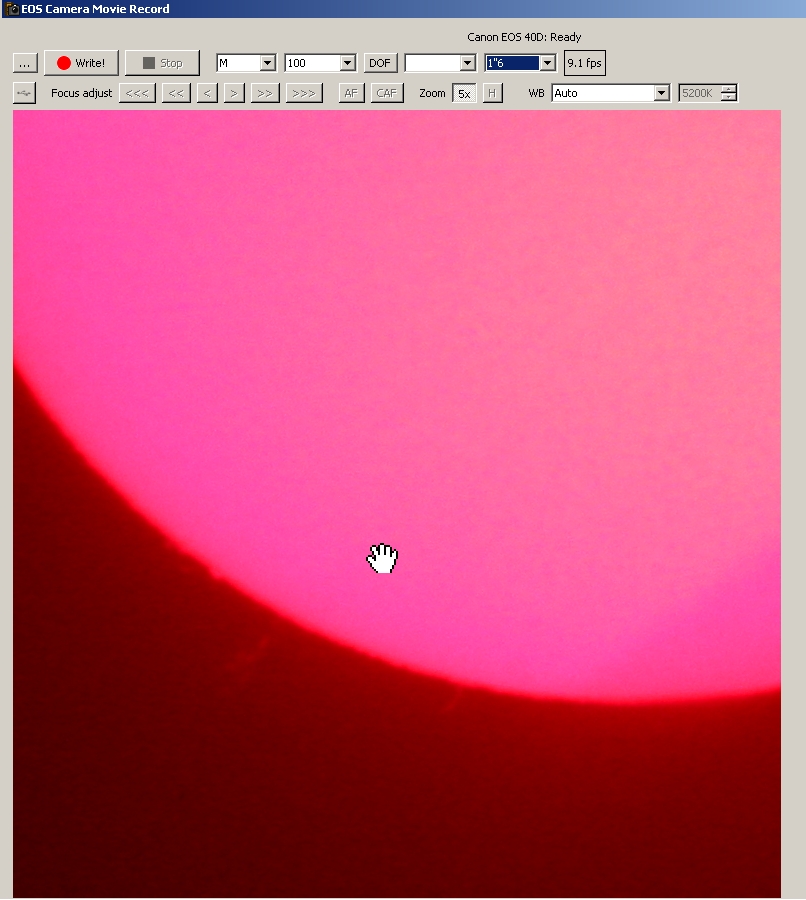
All keyboard shortcuts in version - 0.1.10
beta :
1-6 - focus control
r - start recording
s - stop recording
o - reconnect
d - toggle DOF
z - toggle 5x zoom
i - toggle image preview
Note : Test the quality of the saved AVI (luminosity ...) before starting a full night of captures !
It may happen
that your movies are still overexposed even when changing the ISO or Exposure
on the EOS-movrec !
I have experimented that already when doing Halpha solar acquisitions ...
The solution is to set "simulated liveview" in the custom functions
of the setup menu of you Canon EOS.
Then after adjusting in the software menu for good looking nicely exposed frames,
the saved AVI will be Ok
Example here (sorry captures taken through clouds... no choice !)
Registration of 200 out of 873 with Registax5 (Hint try V5.1!)
1- Liveview in standard mode : overexposure even with 100 ISO and 1/4000s set
in menus
2- Liveview in simulated mode : exposure is good, details are seen in live enhanced
here and colorized (3). You can download larger image (right click).
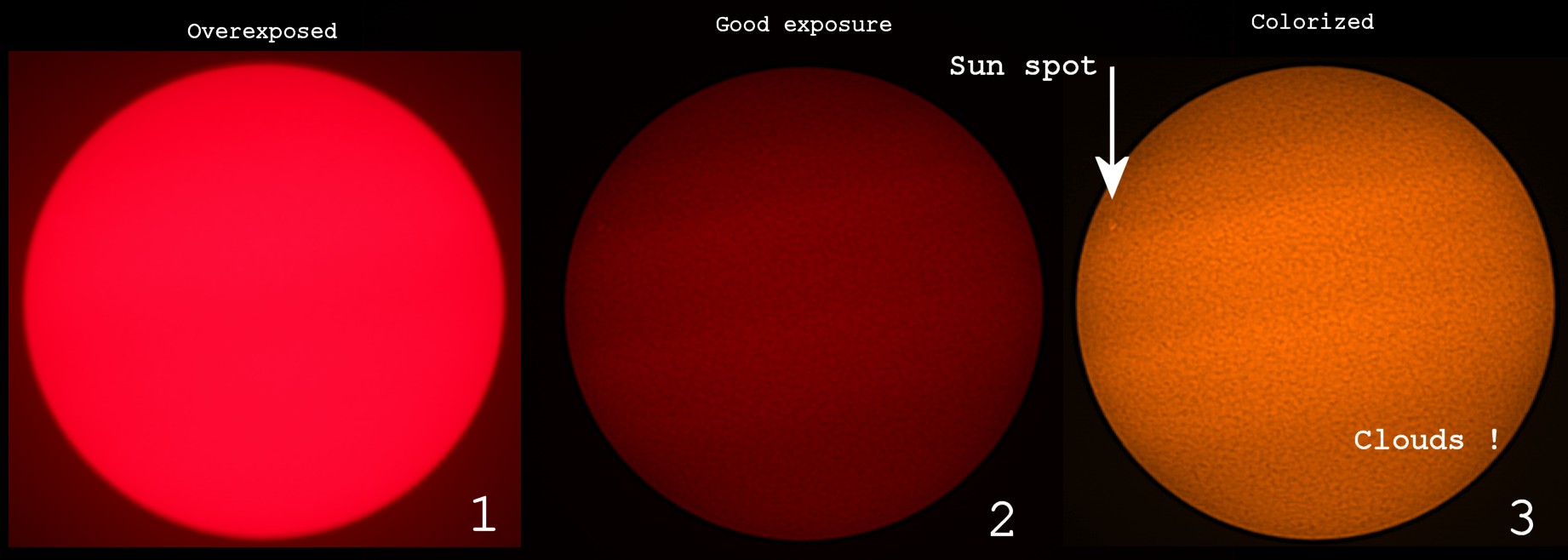
Issue in Registax 5 !
(Thanks to John Johnson for improving my english !)
If you receive the following error message
when trying to load the EOS Movrec AVI files into RegiStax 5:
"Failed to start AVI decompression
: codec:MJPGvids"
Then follow these instructions:
1. First ensure you have downloaded and
installed the latest version of Microsoft's Directx application program, then
reboot your PC.
2. After rebooting your PC look for one
of the Movrec AVI's that you had problems with. Click on the AVI to run it with
Windows Media Player. Windows should ask you then to finalize the installation.
3. Restart Registax5. Look for the "Extended
Mode" and the "Use Extended mode for" control button bars. Click
on the "Default" button in the "Extended Mode" bar. In the
"Use Extended mode for" bar, click on the "always" button.
4. With the above buttons set, then attempt
to load the Movrec AVI's. As you "click" on a file, it should be read
okay, and a thumbnail should appear on the right with some data on the AVI file
above it. The file should then load successfully into RegiStax.
5. The above instructions should allow
you to load the Movrec AVI's. If you are still having problems, you may want
to try "clicking" on other permutations of the buttons described above.
(SCT 12", barlows 5x Powermate => 15m focal length,
FD 50)
Custom White Balance (defiltered 40D for astronomy)
Focusing with the help of ScreenVision
at the start of each AVI.
Capture while in 5X zoom !
Capture at about 20-25 fps.
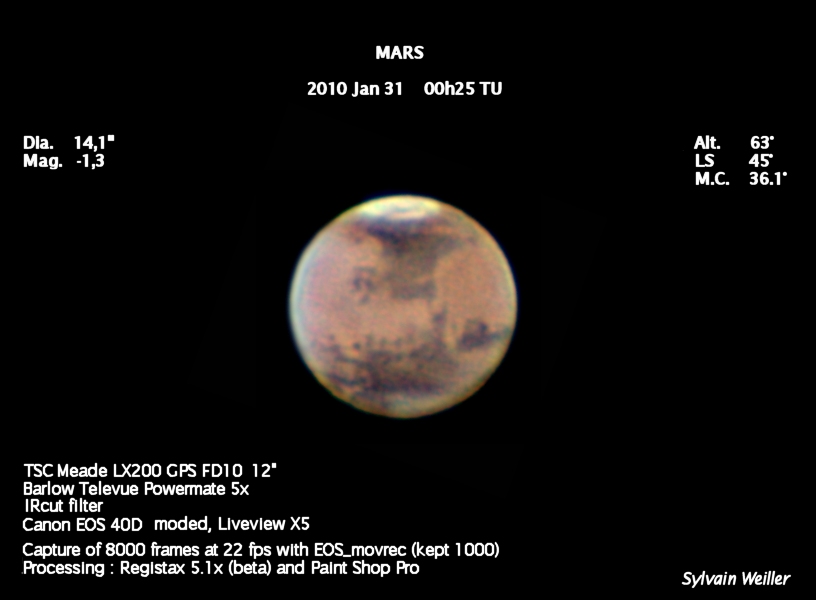
Mars on January 30, 2010
This picture in the result of a registration of 1000 frames (see below) by RegiStax5.
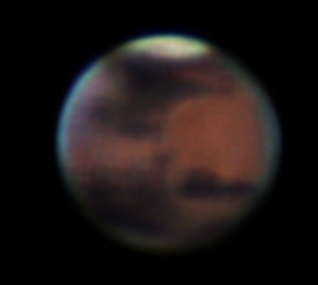
Jupiter on december 16, 2009,
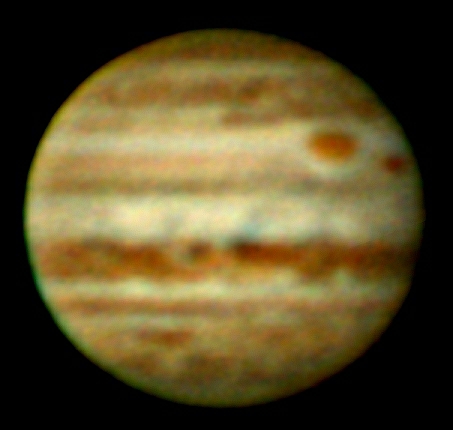
Below : Aspect of full size raw image on PC/EOS-Movrec screen
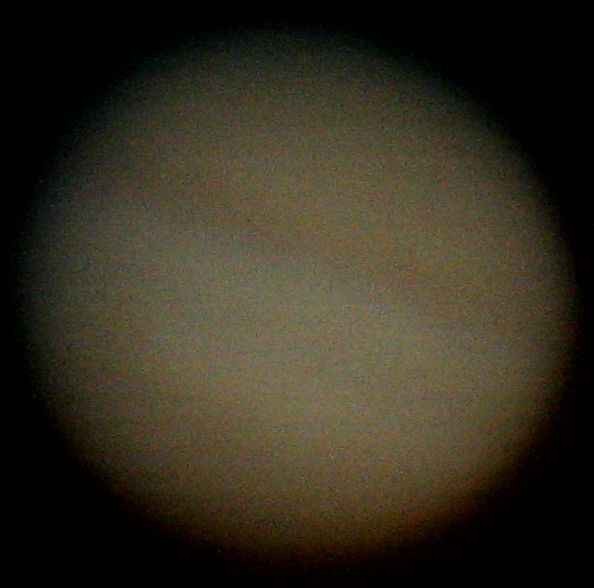
Jupiter on december 10, 2009,
(SCT 12", barlows 5x Powermate => 15m focal
length, FD 50, just recollimated)
Custom White Balance (defiltered 40D for astronomy)
Focusing with the help of ScreenVision
at the start of each AVI.
This picture in the result of a registration of
1800 images by RegiStax5.
Capture at about 22 fps.
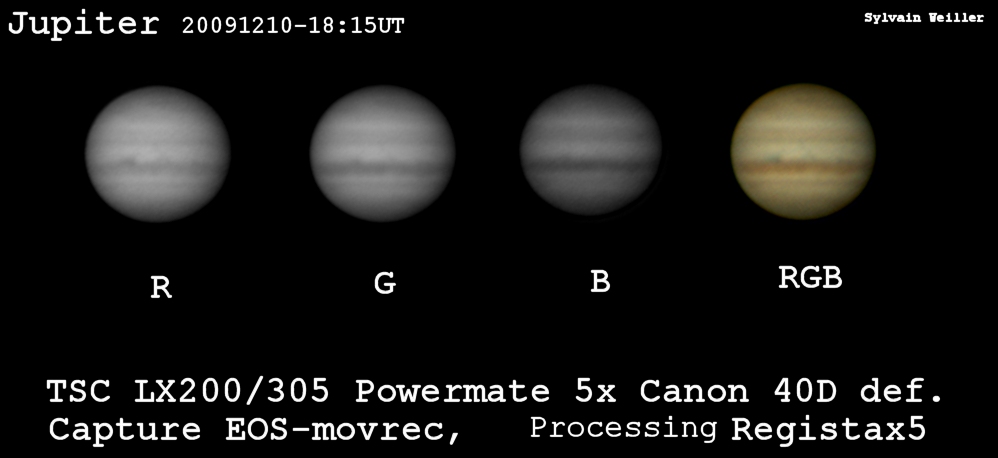
Mars in december 2009, Mars is still looking
very small (less than 7") even in a 10" SCT !
(SCT 10", barlows 2"-4X Televue =>
10m focal length, FD 10)
Custom White Balance (defiltered 40D for astronomy)
This picture in the result of a registration of
364 images out of 1458 of the AVI by RegiStax5.
You can see the size of the frame compared with a Toucam...
Even small, the quality is really there and many details are visible.
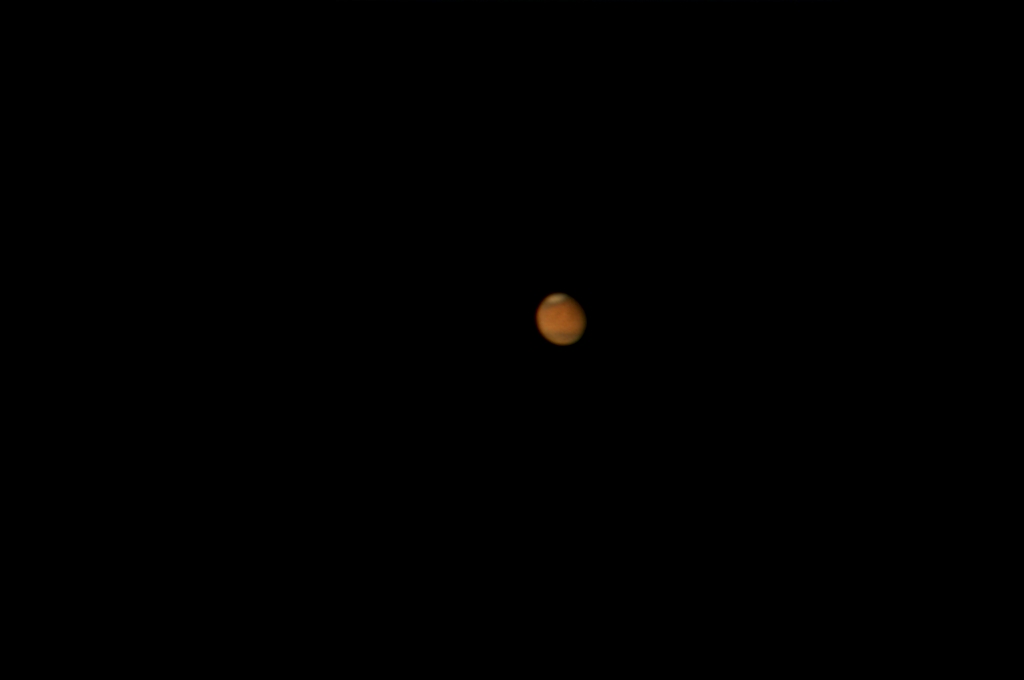
Look for orographic clouds and morning mist
better seen in the blue layer (cropped !)
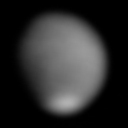
It is remarquable that this blue layer is noise free compared to a usual webcam (here zoom 2x) !!
Here is a small portion of another AVi in GIF (SCT 10", barlows 4X +2.5 X Televue in line => 25m focal length) :
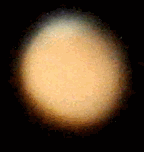 (cropped with VirtualDub !)
(cropped with VirtualDub !)
Here is a registered image from another AVI,
The Moon this time (SCT 10", barlows 2"-4X Televue => 10m focal
length) :
BTW see the Screen
Vision window at upper right where the crater details are enhanced...
Notes :
1- Seeing was not really good ...
2- With this setup at 10m focal length I am not far from the same FOV as with
a commun webcam at 2m focal length !
3- In Registax5 I used the "expand to maximum image size" option.
Then the field here is wider than the capture field (caused by drift). I kept
it like that but also blurred the bottom and left parts of the resulting image
(see blurred Plato)
because these parts had much less captured images for stacking and showed more
noise and multipoint alignment artifacts.
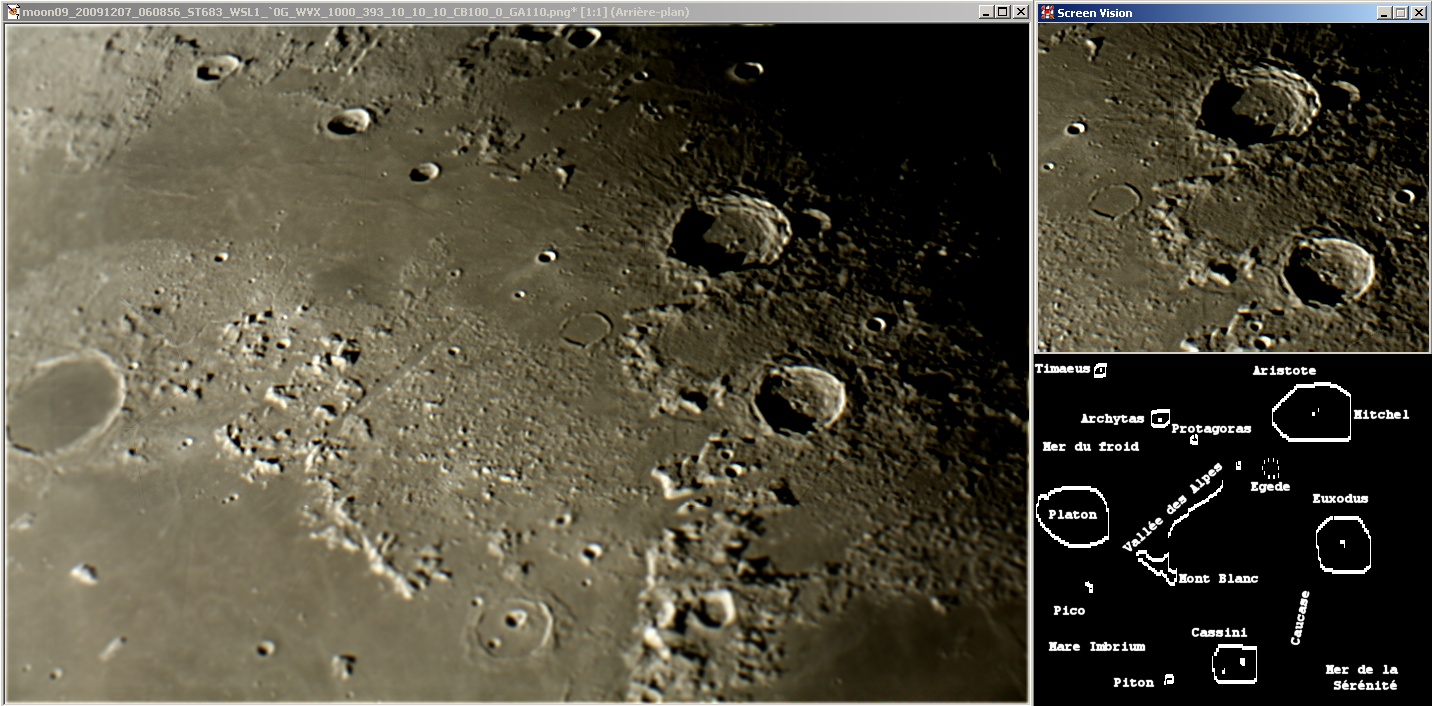
Here is another registered image (same night),
Mare Serenitatis (SCT 10", barlows 2"-4X Televue) :
Notes :
Seeing was really not good 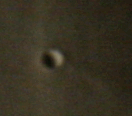 then Registax5 in multipoint did its best but a couple of artifact joint lines
are still visible...
then Registax5 in multipoint did its best but a couple of artifact joint lines
are still visible...
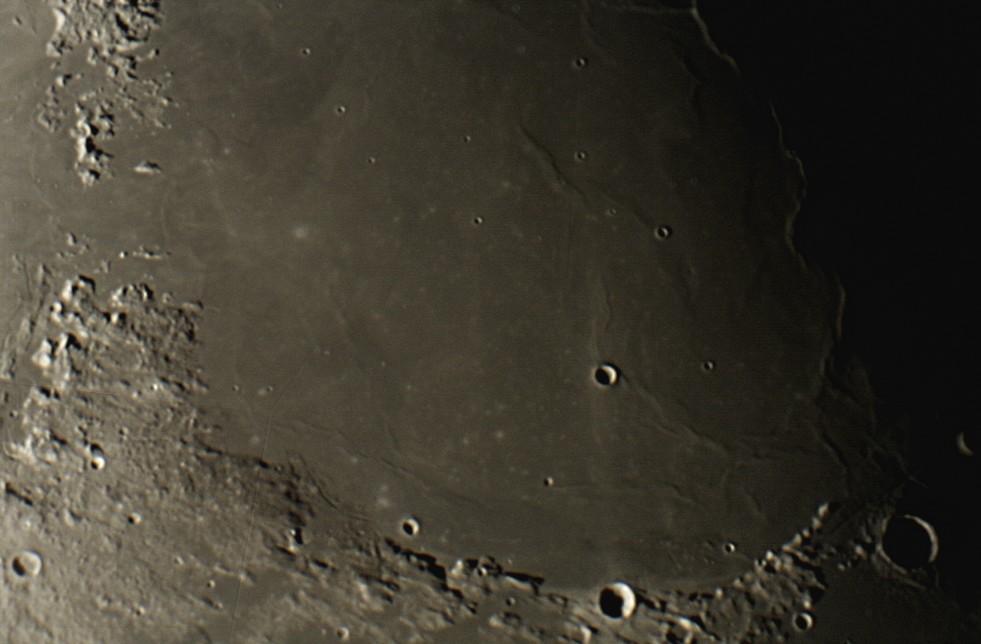
Here is another registered image (same night), left of Theophilus, Cyrilus & Catharina craters (SCT 10", barlows 2"-4X Televue) :
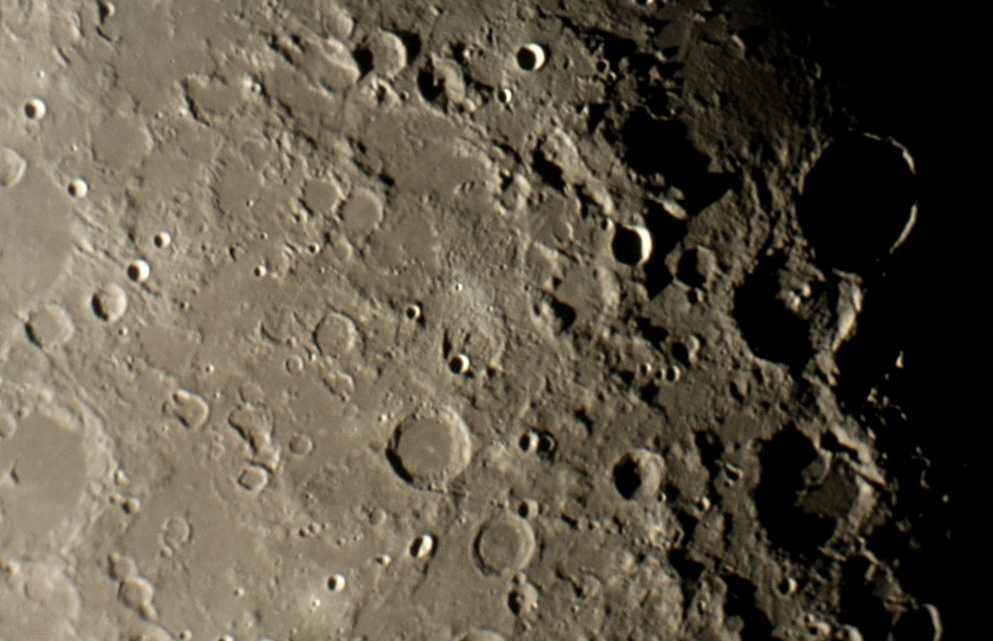
Here is another registered
Moon image (20091225 18h17UT, 1min movie at 20-25fps, 52 stacked),
poor seeing but still a nice perspective ! (SCT 12", 6.3 reducer, Canon
EOS in liveview 5x) :
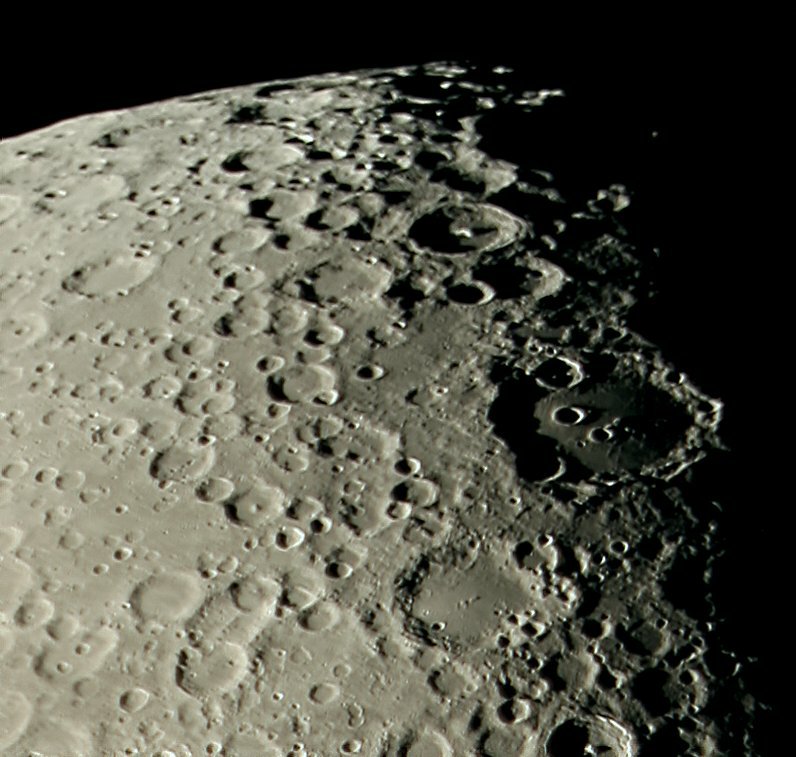
Tonight got a nice seeing on Mars...
Nothing is more easy as using the Canon as
a webcam : Mars on Canon screen to keep the planet centered and to enjoy the
view
and Mars captured at the same time on the PC (but black screen to have 25 fps
capture speed) !
Here is the view at the Canon with Mars dancing live and so much details visible ... and also at right the resulting image after Registax5 !
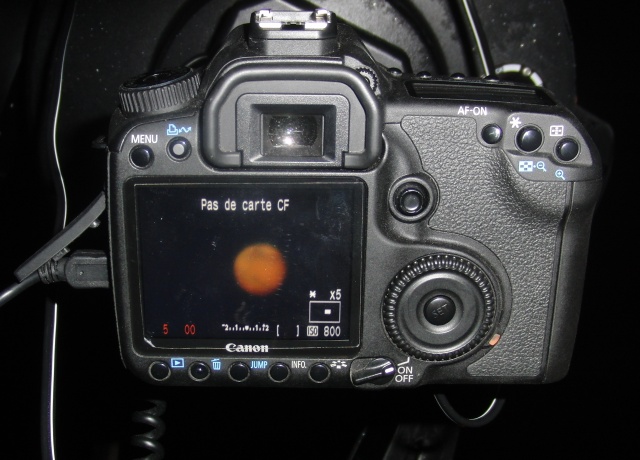
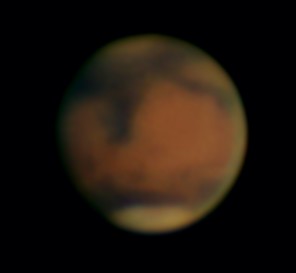
Enjoy !
Back to Home page
-----------------------------------------
*All values shown
for Canon EOS 40D. Will differ in better or worse for other models.
----------------------------------------------------------------------------------------------------------------------------------------------------------------------------
Older and first trials (May 2009) ...
ISS
20090515-2024UT Mag-2 LX200-254FD10 Canon 40D in liveview
3200ISO 0.8ms Exposure Movrec
Search for ISS presence and recentering : RegiStax5 gravity mode.
Best image ! Gif animation in real size :) Conclusion : use a barlow to obtain
about 6m focal length !
I did it 1h30 later at the 2nd dimmer pass :
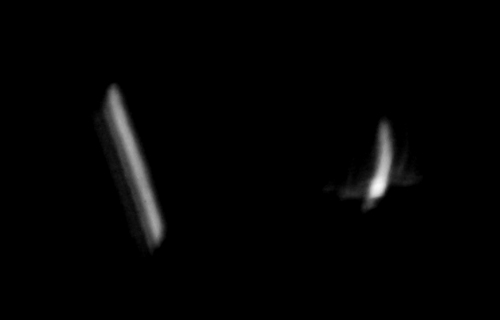
20090515-2159UT Mag-1.2 LX200-254FD56 (4x barlow + 1.4
extender) 3200ISO 0015(1/640)s Expos Movrec
Search for ISS presence and recentering : RegiStax5 gravity mode.
Got larger but blurred images. Next time I should try >= 1/1600s exposure
especially if Mag >-2 !
Saturn
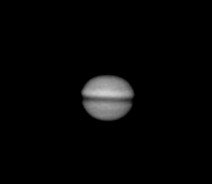
20090515 B4x LX200-254 3200ISO
Movrec & Registax sur 1900 frames.
Not enough sensitivity to capture the thin rings but the disk is nice !
Jupiter should give sone better results.